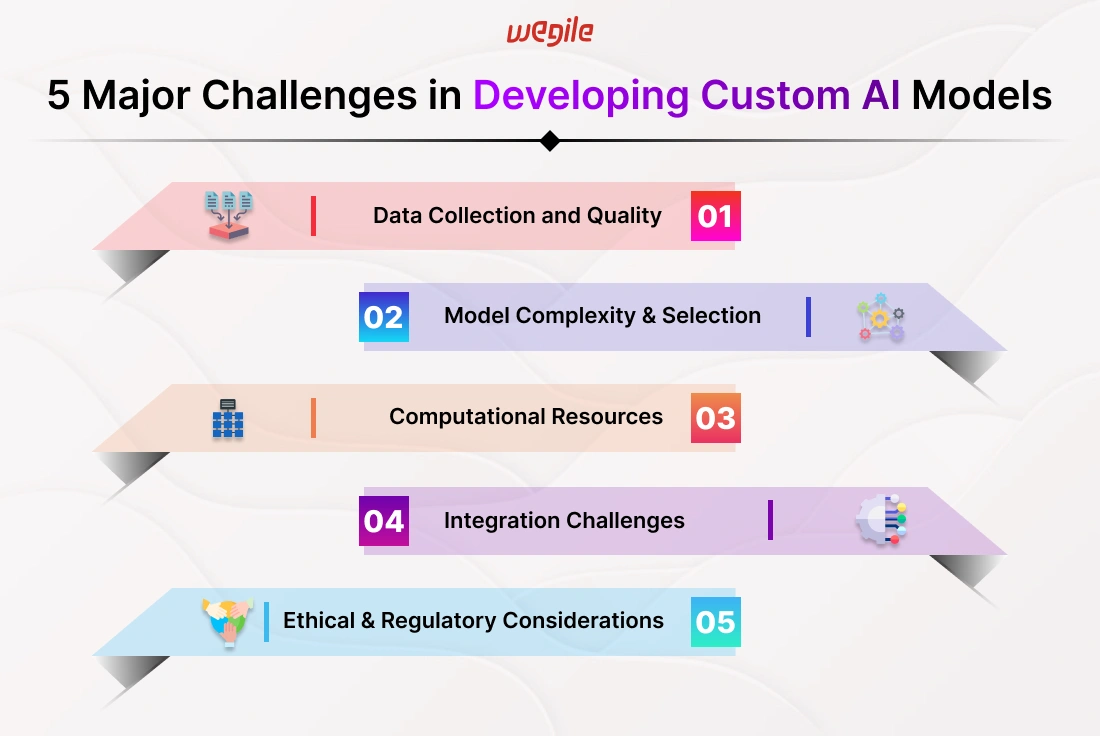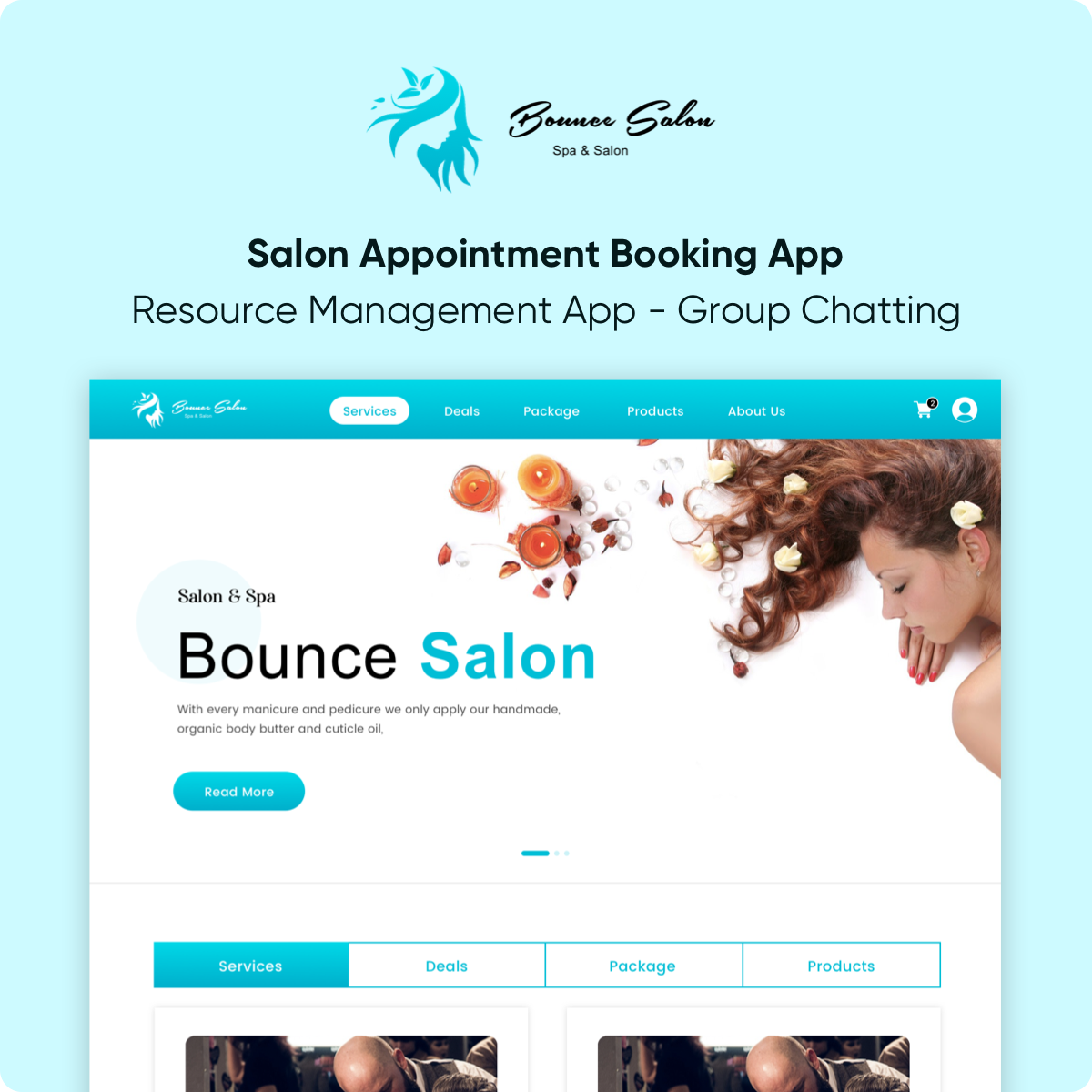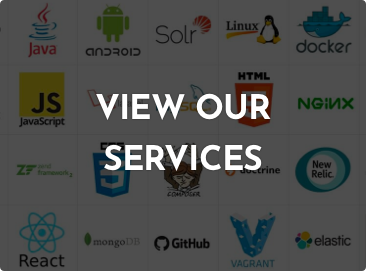We live in a world where technology shapes every aspect of our lives. Custom AI models are essential for innovation and efficiency in this extensive technology era. These tailored solutions help businesses and organizations leverage specific data and workflows to address unique challenges. Custom AI models are outperforming generic AI models that lack a touch of customization. But, the road to developing these specialized models is filled with hurdles ranging from data management to ethical concerns.
This blog will explore the fundamental challenges encountered when constructing custom AI models.
So, let's uncover the details of custom AI model development and learn how to fetch their full potential in various industries.
Custom AI models are intelligent models designed to meet the unique requirements of a business or project. They differ from ordinary and off-the-shelf AI models that offer only a one-size-fits-all solution. These custom models have the precision to utilize the specific type of data. They also grasp an organization's operational nuances and allow it to achieve more accurate results and operational efficiency.
There are peculiar distinctions between traditional AI models and custom AI models. Custom AI models are highly adaptable to an organization's specific challenges and data environments, which ensures they perform better in specialized tasks than their generic counterparts. Another great perk that custom AI models offer is exclusivity. As they are customized, they can combine proprietary features and capabilities absent in basic AI models. We can thus conclude that custom AI models are way more promising and advanced than ordinary AI models.
Industries like healthcare, finance, hospitality, and retail are gaining a significant edge from custom AI models. In healthcare, custom models digest and analyze patient data. They can use this analyzed data to predict outcomes and personalize treatment plans effectively. Customization in healthcare can streamline processes, enhance patient satisfaction, and improve recovery. In the finance sector, custom AI models help detect fraudulent transactions, and automate risk assessments with a high degree of accuracy.
Hospitality sectors use custom AI to personalize their websites and digital offerings by understanding user’s needs and moods. Retail businesses use custom AI to enhance customer experience through personalized recommendations. Custom AI models also find extensive uses in inventory management.

One of the primary hurdles in custom AI development is acquiring high-quality and relevant data. Without sufficient data, AI models cannot learn effectively. This further leads to inaccuracies in predictions and decisions. The challenge intensifies when the available data is of poor quality and contains errors. This challenge is even more aggravated when the data has inconsistencies and biases. These parameters can directly affect the performance of the custom AI model. For example, inaccurate data can lead to incorrect diagnoses in the healthcare sector. It eventually hampers all the treatment plans and puts patient health in danger.
Getting the appropriate model architecture for specific tasks is yet another challenging issue. The complexity of an AI model often relates directly to its ability to perform complex tasks. But, highly complex AI models require more data and computational power. They also need more expertise to develop and maintain. This complexity can lead to models that are difficult to manage and update. It ultimately impacts their performance over time. For example, a highly complex model used in automated trading might perform exceptionally well under stable market conditions. On the other hand, it can miserably fail to adapt quickly to sudden market shifts without extensive fine-tuning and retraining. This can have severe consequences and might result in heavy financial losses or missed opportunities.
Developing and running custom AI models requires considerable computational resources, which can lead to high costs. Training complex models, particularly those involving large datasets or deep learning, further demands powerful processors and a lot of memory. These resource requirements multiply as businesses aim to scale their AI models to regulate more data or provide more insights. It necessitates investment in expensive hardware or cloud services. This challenge can restrict the ability of small to medium enterprises to use advanced AI technologies effectively.
One of the biggest hurdles is integrating AI models with existing IT infrastructure. Many organizations face difficulties deploying AI systems due to compatibility issues with current software and hardware. For example, older systems may not support integrating novice AI technologies without substantial upgrades or modifications. The AI deployment might also need changes in existing business processes and systems. This can further disrupt operations and require significant time and effort from IT departments to guarantee smooth integration.
Ethical concerns and regulatory compliance are also critical challenges in custom AI development. Data privacy, algorithmic bias, and transparency are at the front of ethical AI discussions. For example, AI models trained on biased data can lead to unfair outcomes. They can result in discriminatory hiring practices or biased credit scoring. Similarly, transparency in AI processes is crucial for building trust. Trust building is significant in sectors like healthcare and finance, where decisions directly affect people's lives. Plus, different geographic regions have varying regulations governing data use and AI deployment, which organizations must deal with carefully to avoid legal repercussions.
A crucial step in developing effective custom AI models is data management. It involves both the improvement of data collection methods and the assurance of high data quality. Implementing robust data governance practices ensures data is accurate, consistent, and ethically collected. Advanced data capture technologies can help gather data more efficiently. They also help in reducing the errors often found in manual collection processes.
Tools and techniques like data normalization, handling missing values, and outlier detection are essential for data preprocessing. These methods help refine the dataset, making it more suitable for training AI models. Automated data cleaning tools can also play a significant role. They allow developers to spend less time on data preparation and more on model development and iteration.
Simplifying the model architecture in custom AI model development is vital to enhancing performance and reducing computational demands. Techniques like model pruning can be employed where unnecessary or redundant model parts are trimmed without compromising the model’s performance. This makes the model lighter and faster and reduces the resources required for training and inference.
Using Automated Machine Learning (AutoML) platforms facilitates optimal model selection. AutoML helps identify the best model architecture and parameters for a given dataset and task without requiring deep expertise from the user. This technology automates the model selection process. It speeds up the development cycle and ensures that the deployed models are efficient and effective.
Utilizing cloud resources and edge computing is a strategic solution for managing the significant computational loads associated with custom AI models. Cloud computing offers scalable resources on demand and authorizes organizations to access mighty computing power and storage capabilities without the upfront cost of physical hardware. This is quite beneficial for training large AI models that require massive processing power.
Edge computing complements this by processing data locally, on or near the device where data is generated, rather than sending it across long routes to data centers or clouds. This reduces latency and increases the speed of data processing. It also helps maintain functionality even with intermittent connectivity. Hybrid deployments that combine cloud and edge computing bring together the best of both worlds; they offer scalability from the cloud with the responsiveness and data locality of edge computing.
Sticking to robust integration practices is crucial for seamlessly integrating AI models into existing business environments. It involves confirming that the AI models are compatible with the existing IT infrastructure and can interact effectively with other systems and software.
Successful case studies often highlight the importance of a well-planned integration strategy. For example, a financial institution integrated AI into its existing risk assessment systems to improve fraud detection rates without disrupting ongoing operations. This was achieved by gradually implementing AI functionalities and ensuring they were fully compatible with existing data management systems.
Implementing ethical AI frameworks includes setting up guidelines that supervise the development and use of custom AI models to ensure they are used responsibly. These frameworks help address data privacy, algorithmic bias, and transparency. Regular audits and compliance checks are keys to maintaining adherence to these guidelines, which ensure that AI systems operate within legal and ethical boundaries.
For example, an international tech company implemented a comprehensive ethical AI guideline that included routine audits to check for data bias and ensure transparency in how AI systems made decisions. This helped align AI systems with regulatory requirements and build trust among users and stakeholders by demonstrating a commitment to ethical standards.
Zebra Medical Vision: Focusing on medical imaging, Zebra Medical Vision tackled significant data privacy and compliance hurdles by adhering to stringent regulations like HIPAA. They used anonymized patient data to train AI models, ensuring patient privacy and model effectiveness. Their custom AI solutions now assist doctors by identifying indicators of diseases such as liver fibrosis and cardiovascular illnesses. This further enhances diagnostic accuracy and potentially saves lives through earlier detection.
Stitch Fix: Stitch Fix is an online personal styling service that uses custom AI models to personalize clothing selections for its customers. Progressively integrating AI with existing systems allowed them to refine their algorithms without disrupting the user experience. This strategic approach has encouraged them to enhance customer satisfaction by accurately predicting and aligning with consumer fashion preferences. This is now helping them drive higher engagement, 10x revenue, and retention rates.
JPMorgan Chase: JPMorgan Chase developed the COIN program to automate the interpretation of commercial loan agreements, a process that typically requires 360,000 hours of lawyer work each year. By using natural language processing and custom AI models, they reduced errors and saved thousands of hours. They eventually streamlined operations and reduced costs. The successful integration of custom AI into their existing digital infrastructure demonstrated a significant improvement in efficiency and accuracy in their legal documentation processes.
Tesla: The automotive giant integrates custom AI models into its vehicle manufacturing processes to optimize production and enhance its cars' safety features. Tesla utilizes advanced in-house hardware and software specifically designed for its production lines to address scalability and computational demands. This helps it maintain high efficiency and innovation rates and guarantees its vehicles are safe and technologically advanced.
The journey to developing custom AI models is complex and involves many challenges ranging from data management to ethical considerations. Despite these hurdles, the examples detailed above show that these challenges can be successfully overcome with strategic approaches. Organizations across industries from healthcare to automotive have successfully harnessed the power of custom AI to enhance operational efficiency. With custom AI models, organizations are successfully improving customer experiences and driving innovation. This blog has outlined the challenges, strategies, and real-world examples that illustrate the profound impact of custom AI models. As technology continues to evolve, the importance of ongoing learning and adaptation in AI development cannot be ignored. Welcoming these practices will enable organizations to remain competitive and make the most of AI technologies.
At Wegile, we use our expertise as a leading AI app development company to create remarkable solutions tailored to your business needs. Whether you're looking to innovate operations, revamp customer engagement, or streamline processes, our team is equipped to deliver the most promising custom AI applications that drive success. Join us in converting your ideas into reality with the power of AI. Reach out today to learn how our customized AI solutions can benefit your organization.


 Browse Our Services
Browse Our Services
